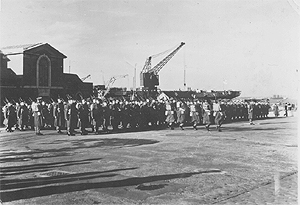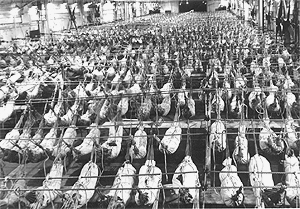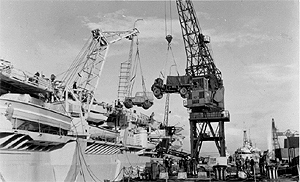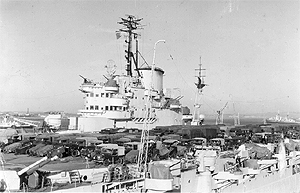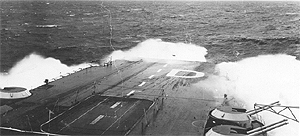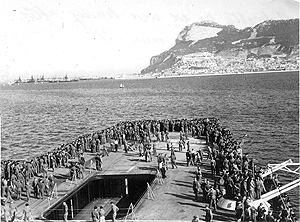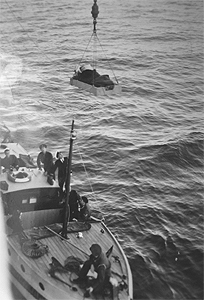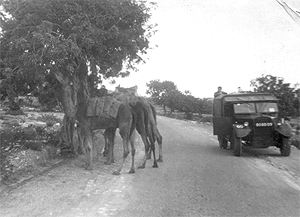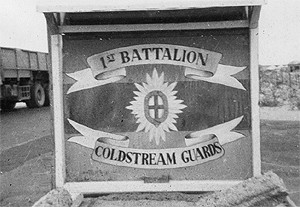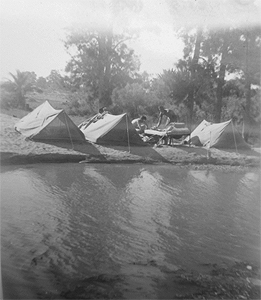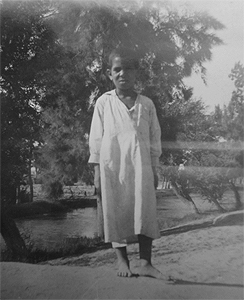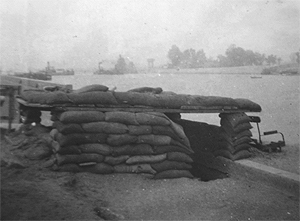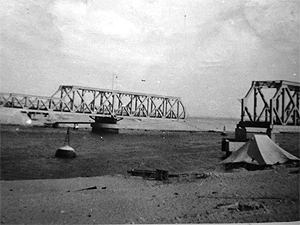MOVE FROM WINDSOR TO THE CANAL ZONE VIA CYPRUS
I joined the Coldstream Guards in November 1950 and, after months of gruelling and frightful experience as a recruit at the Guards Depot, Caterham followed by 12 weeks field craft & weapon training at Pirbright and battle training on the Yorkshire Moors at Pickering, I managed to pass out as a trained Guardsman. What a relief when in June 1951 I was posted to No. 3 Coy of the 1st Btn. stationed in Victoria Barracks, Windsor.
During that autumn we went on exercise on Salisbury Plain and, fortunately for me, I didn't have to dig slit trenches or 'stand-to' in ankle deep water as I'd been temporarily attached to the M.T., having trained as a civilian HGV mechanic and driver. I slept in my 3 Coy Baggage 15cwt with CSM ‘Geordie’ Reid. After the exercises Capt. F.W.R. Fisher, the MTO, retained me and that's how I got involved with the M.T.
In mid-October the Battalion was put on 28 days
notice to move to the Middle East as a unit of 32 Guards Brigade. Then on
the 22nd November 1951, less than a year after the 1st Btn had returned from
a tour in Tripoli, we entrained at Windsor for Portsmouth. We were to board
the aircraft carrier ‘Illustrious’, the main hanger of which had
been strung with 1500 hammocks. We paraded in Greatcoat Order in front of
the Victory before boarding.
|
1st Btn formed up at Portsmouth |
Hammocks strung in HMS Illustrious hanger |
On board with us were the 1st Btn Beds. & Herts., 49 Field Regt. RA. and other units of 3 Inf. Div. Our transport and large items of equipment were loaded onto the flight deck
Loading trucks onto HMS Illustrious, Portsmouth
|
32nd Guards Brigade trucks loaded
|
The Bay of Biscay was very rough and the sea broke over the bows as the ship ploughed through the waves.
|
HMS Illustrious - rough seas in the Bay of Biscay |
We dropped anchor outside Gibraltar Harbour while a Guardsman who had been operated on for appendicitis by the ship's medical staff was landed.
HMS Illustrious at Gibraltar |
Landing a sick Guardsman at Gibraltar
|
But HMS Illustrious reached Famagusta Harbour in Cyprus on 29th November. We were offloaded onto rather dangerous looking flat-decked lighters, the Illustrious being too large to dock at the quayside. I was not a happy bunny, as we were crowded onto the lighters in full kit, blankets and rifle etc. - an accidental shove could easily have sent us overboard to the bottom, but we made it.
An assortment of local transport carried us to Polemedhia Camp close to Limassol. It was pouring with rain (as it did for the next 2 months) as we struggled up the hill to collect our mattresses and bedding for our tents. We remained there, presumably ‘standing by’, until we were needed in the Canal Zone.
Our MT trucks had been collected and we covered logistic runs and work for the Quartermaster staff. Our regular routes were mainly to and from Limassol, Larnaca, Famagusta and Nicosia. Thereby hangs a tale.
Gdsm. Norman Smith did the daily mail run to Nicosia. There was to be a vehicle inspection on a given day and that day on his return from Nicosia he lifted his Land Rover bonnet and sprayed petrol from his fire extinguisher onto the engine hoping to clean up inaccessible places. Unfortunately he set fire to the Land Rover and also Capt. Towers' new Ford Consul saloon that was parked in the garage next to him. Wow! What a mess!! Poor old Smith N. Soon afterwards the following poem appeared on the MT. Notice Board
Guardsman Smith N. usually thick
Can send a Land Rover up in a tick
On red-hot engine he does flick
POL till the flames do lick
(Sorry but I cannot recall the rest of the poem)
My truck was a 15 cwt. Ford WOT 2 - the one I'd driven on Salisbury Plain exercises and the photo was taken when I stopped on the way to Camp to watch the camel feeding. It was not a good day as I'd been booked by the RMPs for failing to immobilise my truck outside a roadside cafe where the Sergeant with me asked me to stop
|
Camels grazing at the side of the road
|
Later, in mid January 1952, came reports of violent riots and murders as the situation in Egypt worsened. Plans were made for landings on the Alexandria beaches to restore order and protect the European population and subsequently shelved but I do recall that on 6th February 1952 I was aboard the Empire Doric bound for Port Said when the BBC announced the death of King George V1 that morning.
Having disembarked at Port Said we were transported to St. Louis Camp, located within the perimeter wire of Tel-el-Kebir (TEK) where we took up Garrison Duties. We were accommodated in tents and some worked in old huts previously occupied by the Mauritian Pioneer Companies - so it was pretty basic. The MT drew up some 2nd World War Dodge 3 Ton Cargo trucks that we used for garbage collection and whatever tasks we were allotted. We were also responsible for perimeter defence, main gate guards, manning searchlights as well as mobile and foot patrols along the wire. But this didn't stop the Egyptian ‘Clefty Walla's’ breaking in and stealing anything of value. We weren't there long, for on 17th February 1952 we moved to Wolseley Camp, El Ballah.
The camp was situated on the Treaty Road between El Kantara and Ismailia, lying between the so-called Sweet Water Canal and the Suez Canal. The Battalion was there for about 18 months - surrounded on all sides by sand, sand, and more sand. Flies, flies, flies were always plaguing us by day and the dreaded mosquitoes at night. Boring, boring, boring!! Guards, guards, guards day and night!!
|
The Camp Sign |
Responsibilities included a detachment sent to Port Fouad on the East Bank of the Suez Canal, another guarding the El Kantara Ferry and Fresh Water Pumping Station, while the MMG platoon protected the track from the desert into El Ballah and El Kantara, the objective being to deter terrorists.
I was, on one occasion, deployed with a platoon to a location close to El Kantara. Our orders were to 'Guard the Western approaches to Cairo' . We spent some time bivouacked there but didn't encounter any terrorists other than a few curious children, perhaps budding extremists.
Our bivouacks |
One of the "intruders"! |
The outlying companies and platoons were withdrawn in April 1952 so that the complete battalion was located in Wolseley Camp, El Ballah. Our operational role continued to be the occupation of Alexandria if tasked to do so and troop movements by air from Canal Zone airfields were practised.
Meanwhile the battalion continued its day-to-day existence in Wolseley Camp apart from watching /guarding the El Kantara Ferry on the Port Said - Ismailia Road about 30km. north of Ismailia and the El Firdan Railway Swing Bridge spanning the Suez Canal near Ismailia. (The bridge shown was replaced after being destroyed during the Arab-Israeli Six day War in 1967).
El Kantara outpost |
El Firdan Bridge over the Suez Canal |
The Battalion was also tasked with raiding villages near the Sweet Water Canal searching for stolen property, arms and suspected terrorists. Like the Paras and other units we operated anti-cable-cutting patrols in Land Rovers fitted with angle iron structures mounted on the front bumpers to counter the ‘wire across the road obstacles’, followed by an armed escort vehicle. As readers will know single vehicles weren't allowed to travel due to the risk of ambush.
I recall being Sergeant of the Guard at the nearby Water Filtration and Purification Plant. We mounted night-guard in greatcoat order because it got so cold during the night - in contrast to the dusty intense heat of the day. Tall well-built Sudanese men armed with cudgels patrolled the depot all night long supporting the guard. My first orders after scheduling duties was for all to get out and collect as much wood as possible to burn on the slow combustion stove. Enough to last throughout the night. Once alight we clustered around the stove with the lid open intent on keeping warm. The Sudanese could get on with the patrolling whilst we hogged the fire. On dismounting the following morning our eyes glowed white while the rest of our faces were blackened - we looked like Black and White Minstrels. We were not attacked.
In October and November 1952 the battalion took part in Brigade and Divisional Exercises in the South and if my memory serves me right I recall getting a call from the CO who was in the Bedford Office Truck somewhere in the desert. “Sgt. Walklin send me a chair right away” and gave me a map reference. It was late and, not wishing to drag a driver from his pit, I asked L/Sgt. Harry Simpson, my storekeeper, to grab his Sten and a chair. We somehow crammed into our Daimler Scout Car with Harry perched on the chair in the turret and sped off into the desert. We came across a narrow sandy track close to a river near the map reference and spotted lights. “That's it. Let's go along the track.” Not a good idea. We were heading towards an Egyptian army outpost. I was driving - Harry screamed out – “Quick, turn round!” I attempted to do a multi-point turn but got bogged down to the belly plates. I could just get my hand between the plate and the sand. We dug at the sand like rabbits to clear sand from the front and rear of the wheels and by some miracle we edged forward and escaped before the Egyptians realised what was happening. I didn't explain the delay to the CO.
It seems that Harry and I tempted ‘Providence’ on more than one occasion. An officer ordered a Land Rover to take him from El Ballah to Ismailia where he was to dine with very senior Staff Officers. With Harry as my escort we drove to the Officers' Mess and picked up the officer, drove to the destination without trouble and set him down. He told us to lose ourselves and return at 'X' hours. And lose ourselves we did!! We drove past a sentry who was leaning against a sentry box smoking into the Egyptian Army Barracks. “Oh Gawd! Got your Sten Harry?” “No, its in pieces under my seat.” “Well f---ing well get it sorted!!” While Harry struggled to extricate the weapon from beneath his seat, I drove flat out around the barracks and out of the gate with Egyptians screaming and rushing about like lunatics.
In December 1952 a large detachment was sent to Abu Sultan Base Ammunition Depot where we were to stop the Egyptians from stealing materiel. We'd heard a rumour that 6 tons of ammo was being stolen each night. My role as MT Sgt. was to supply and maintain transport to carry the patrols here and there and other support duties. The considerable drop in temperature at night caused havoc initially, as our trucks were 3 Ton Ford WOT 6 V8 petrol-engined with the distributor fitted just behind the radiator. Initial result - dampened ignition leads and non-starting problems. So to overcome this we had to start and run the engines every two hours to cure the problem - what we'd have given for diesel engines.
There were barker dog, tracker dog and probably killer dog patrols mounted by professional dog handlers and it was necessary for us to deploy observers by day but at night 100 men had to guard and patrol the 10 miles of mined perimeter wire under the cover of darkness. The MT role was to ensure that the observers and patrols were transported at dusk to variable positions without being spotted by any would-be thieves. Fortunately we sustained no casualties - no one blown to pieces by unmarked mines. No ammunition had been stolen on our watch and we returned to El Ballah at the end of the month.
At the end of this duty we returned to El Ballah and the boredom
of day-to-day duties eagerly awaiting the order to return to UK. The 'time-expired'
old soldiers were kept in Egypt for several months after their release date
in 1952 due to the shortage of transport home. They were quite difficult to
handle especially for a young NCO such as me. They were 'bolo' and couldn't
be blamed for appearing to have a 'couldn't care less' attitude. But nevertheless
they remained highly disciplined men and we younger soldiers learned a lot
from them.
The MT prepared vehicles for several expeditions across the Sinai desert to visit St. Catherine's Monastery, built on the site of the Burning Bush as seen by Moses. On one such trip drivers reported that the commander - OC 2 Coy., Major D.F.D. (Dead Ground) Noel, reportedly a keen botanist, was intent on combing the desert for rare plant life. All returned safely.
In May 1953 five officers and a lucky group of 100 all ranks were flown to UK to participate in the Coronation Parade returning to El Ballah in mid-June. But good news was to follow shortly afterwards. The 1st Btn Welsh Guards was due to relieve us in early September 1953 and this time it wasn't a rumour, it was true.
On 11th September 1953 the 1st Btn Coldstream Guards the main body embarked in H.M.T. Empire Halladale at Port Said and sailed for Liverpool. But what a rough passage we had through storms in the Bay of Biscay. The seas were mountainous - the propeller shaft lifting out of the sea and the engine racing. The bow was dipping and rising alarmingly, rolling over in the troughs. At one instant nothing could be seen but a mountain of sea and next, nothing but sky. Some were too seasick to worry about the storm but I like many others was absolutely terrified!
I count myself lucky to have made it home safely as I was appointed Troop Deck Sergeant. I had the unenviable task of ensuring the troop deck was in pristine condition for the Captain's Inspection at 1000 hours daily. This entailed detailing four guardsmen to grab each corner of a blanket and confiscate everything that was not in authorised locations. Favourite places to 'hide' articles were behind pipes and fittings or under bunks. This meant packs of cards, cigarettes, books, papers, you name it, ending up in the blanket; which was then placed in the luggage hold on the same deck. Stuff could be reclaimed when the hold was opened in the evening. I was careful to avoid a 'mishap' or accidental 'man over board' whilst on the upper deck.
But we made it and disembarked at Liverpool on 23rd. September 1953 where we were paid, given a railway warrant and sent on well earned leave, ending our Suez Canal encounter.
My thanks are due to the estate of Col. R.J.V. Crichton MC. 1 Coldm. Gds.,
once my Commanding Officer for reference to his researches.
Back to Gallery of Les Walklin
